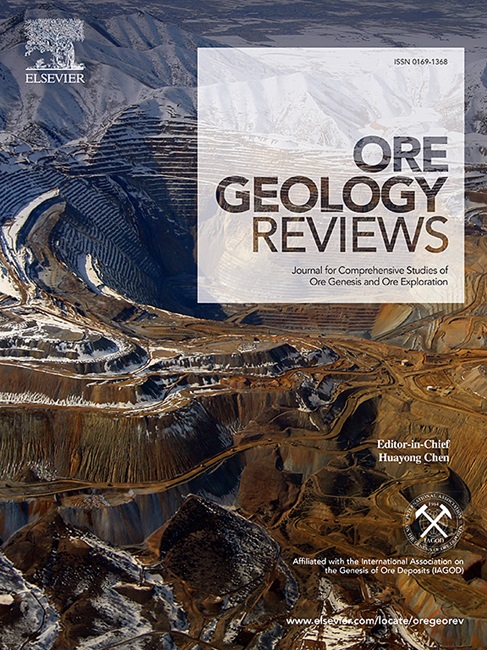变质作用在中国伊春稀有金属矿床形成过程中的作用
IF 3.2
2区 地球科学
Q1 GEOLOGY
引用次数: 0
摘要
后岩浆作用过程在稀有金属过铝花岗岩的发育和成矿过程中发挥了什么作用,以及这种作用的重要性有多大,这些都是研究人员几十年来一直在争论的问题。宜春锂-钽-铌矿床就是这样一个争论不休的例子。岩石的花岗岩外观、钽的惰性以及乡村岩石中矿化物的稀少都被认为表明,流体的叠加作用仅限于花岗岩内部,在岩石和矿石形成过程中并不重要。在本研究中,宜春仅有的两个成矿单元--黄玉-鳞片花岗岩和上覆伟晶岩中均发现了两种类型的富锂离子和铯离子假象体,这表明在岩石和矿石形成过程中存在广泛的变质作用。在各种矿点的可比矿物组合中,鳞片岩的纹理和化学成分都很相似,包括黄玉鳞片岩花岗岩和伟晶岩的假象、矿脉和混合岩洞中的鳞片岩、这表明宜春的所有鳞片岩都是变质岩,其化学特征主要来自岩浆-热液过渡液,富含锂、铯和钽,可能来自黄玉鳞片岩花岗岩下的锂锰花岗岩。我们认为,这种过渡液的成分介于硅酸盐熔体和水液之间,与原始火成岩矿物学不平衡,因此在其渗透和向上演化的过程中产生了显著的变质作用。鳞片岩痕量元素成分的变化很可能反映了前驱矿物对矿物成分的影响。黄玉鳞片花岗岩和锂锰花岗岩之间的边界模糊不清,再加上前者具有强烈的变质作用,这最符合黄玉鳞片花岗岩是锂锰花岗岩上部的广泛蚀变,而锂锰花岗岩本身也具有一定程度的变质作用。虽然在花岗岩和伟晶岩形成过程中,岩浆分馏对 Nb、Li 和 Ta 的初始富集起了关键作用,但锂-Ta-Nb-Cs 矿化及其母岩在很大程度上是通过岩浆-热液再富集和再富集形成的。本文章由计算机程序翻译,如有差异,请以英文原文为准。

Role of metasomatism in formation of the Yichun rare-metal deposit, China
What role post-magmatic processes have played in the development and mineralization of rare-metal peraluminous granites and how important that role can be, are questions that researchers have been wrestling with for decades. The Yichun Li-Ta-Nb deposit is an example that has been the subject of such a debate. The granitic appearance of rocks, the inert nature of tantalum, and the scarcity of mineralization in country rocks have been taken to suggest that fluid overprints were limited to within the granites and were unimportant in rock- and ore-forming processes. In this study, the identification of two types of abundant Li- and Cs-rich pseudomorphs in both the topaz-lepidolite granite and overlying pegmatite, the only two mineralized units at Yichun, suggests that extensive metasomatism was involved in rock and ore formation. The textural and chemical similarities of lepidolite in comparable mineral assemblages from a variety of occurrences, including lepidolite in pseudomorphs, veins, and miarolitic cavities from both the topaz-lepidolite granite and pegmatite, suggest that all lepidolite at Yichun is metasomatic and largely inherited its chemical signatures from a magmatic-hydrothermal transitional fluid, rich in Li, Cs, and Ta, derived possibly from the Li-muscovite granite that lies beneath the topaz-lepidolite granite. We propose that this transitional liquid, composition of which lies between a silicate melt and aqueous fluid, was not in equilibrium with the original igneous mineralogy, thus bringing about significant metasomatism along its infiltration and evolution upwards. Variations in the trace-element composition of lepidolite likely reflect the influence on mineral compositions by precursor minerals. The ambiguous boundary between the topaz-lepidolite and Li-muscovite granites, combined with the intensely metasomatized nature of the former, is most consistent with the topaz-lepidolite granite being the extensively altered upper portion of the Li-muscovite granite, which is itself somewhat metasomatized. Although magmatic fractionation played a key role in the initial concentration of Nb, Li, and Ta in both granite and pegmatite formation, the Li-Ta-Nb-Cs mineralization and its host rocks were largely formed through magmatic-hydrothermal rejuvenation and re-enrichment.
求助全文
通过发布文献求助,成功后即可免费获取论文全文。
去求助
来源期刊

Ore Geology Reviews
地学-地质学
CiteScore
6.50
自引率
27.30%
发文量
546
审稿时长
22.9 weeks
期刊介绍:
Ore Geology Reviews aims to familiarize all earth scientists with recent advances in a number of interconnected disciplines related to the study of, and search for, ore deposits. The reviews range from brief to longer contributions, but the journal preferentially publishes manuscripts that fill the niche between the commonly shorter journal articles and the comprehensive book coverages, and thus has a special appeal to many authors and readers.
 求助内容:
求助内容: 应助结果提醒方式:
应助结果提醒方式:


